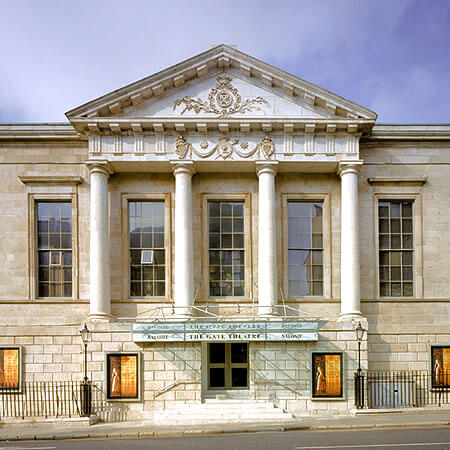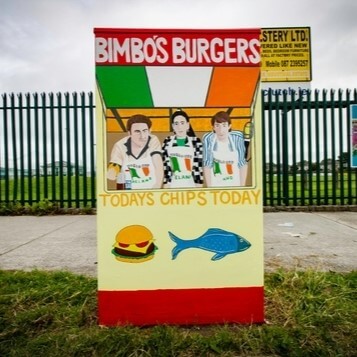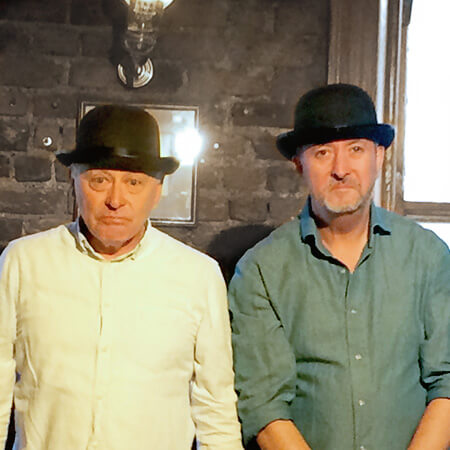Part of the city’s social fabric
The Abbey Theatre has long been part of our city’s story. Nestled in the bustle right at the heart of Dublin 1. You’ll find it amidst the comings and goings from Busáras and Connolly station, the Luas clangs past its door and the River Liffey’s squawking seagulls are within earshot too.
President Michael D. Higgins regularly attends opening nights, a straight run for him down the quays from his residence at Áras an Uachtaráin in the Phoenix Park.
The last time I wandered down that direction, there was a man selling antiques from a van down a lane beside the stage door. It’s not everywhere you can haggle over an old lamp on the way to the theatre.
The early years of The Abbey Theatre
Live for a while in Dublin and life will become punctuated by trips to The Abbey. It’s an intimate space with 500 seats, but it comes with less elbow jostling with your neighbour than other theatres. There isn’t a bad seat in the house. And the drama does not belong exclusively to the stage. The Abbey Theatre’s history is an interesting one.
Born out of the Irish Literary Theatre founded by W.B. Yeats back in 1899, the theatre opened its doors for the first time on a cold December night in 1904. Its purpose? “To bring upon the stage the deeper emotions of Ireland”.

From The National Library‘s collection
In January 1907, J.M. Synge’s Playboy of the Western World led the crowds to heckle and balk at the version of themselves they saw on the stage. Some audience members even threw things at the stage.
The play, which was about patricide and also touched on the topic of women’s lingerie, led to riots in the streets outside because it was perceived to be immoral and an insult to Ireland.
“The frenzy that would have silenced [Synge’s] master-work was, like most violent things, artificial, that defence of virtue by those who have but little…” Yeats said of the debacle.
Despite this incident, The Abbey enjoyed much success and huge crowds attended many of its productions. In 1924, with the founding of the Irish Free State, The Abbey Theatre became the first state-subsidised theatre in the English-speaking world. Its founders strived to find a balance between state funding and artistic liberty.
Later, in July 1951, a devastating fire consumed the building but the theatre was resurrected once again in contemporary buildings on the same site 15 years later. Its current home was opened by the then President Éamon de Valera, who had once graced The Abbey’s stage as an amateur actor.
And the plays aren’t the only art housed here. Today, the busy bar is home to paintings by John B. Yeats and Louis LeBroquy. There is art too in the small accidental conversations that happen at the interval or in the pub after the show.
Continuing to inspire: The Abbey Theatre Now
The Abbey’s days as a place of protest didn’t end in 1907 either. In 2014, an impassioned speech about equality and homophobia by Dublin’s best-known drag queen Panti Bliss started a conversation about LGBTQI+ rights in Ireland and was a major factor that led to the Marriage Equality Referendum in 2015.
That same year, however, the Waking the Feminists movement sprung up in reaction to the under-representation of women in The Abbey’s programme – something which the theatre’s directors have been keen to address ever since.
Success for The Abbey means both reflecting society and helping to shape it.
According to its most recent annual review, the theatre has now struck this balance. In fact, of its 192 roles across writing, directing, design, casting and stage management for the year 2021, women filled 129 of them. The goal is to achieve a 50/50 balance every five years.
Current directors, Caitríona McLaughlin and Mark O’Brien, are a visible example of this newly acquired balance at The Abbey and inclusiveness is a core element of their plans for the theatre. “As co-directors, we are working together to create an environment within which great art and people can flourish,” they say. “[We] aim to promote real collaboration, inclusiveness, diversity and equality.”
Our programme is built… around two questions: who were we, and who are we now?
The theatre’s remit also includes community and education workshops, Irish sign language performances and captioned performances. Beyond inclusivity, they say their priorities are to engage society through ambitious, courageous, artist-led theatre. A mission not too different from that of The Abbey’s original founders.
“Success for The Abbey means both reflecting society and helping to shape it,” they say. “Artistically our programme is built… around two questions: who were we, and who are we now?”

Artistic director Caitríona McLaughlin, board chair Frances Ruane and executive director Mark O’Brien
Generations of Irish actors and playwrights continue to thrive in the shadow of our national theatre. We’ve seen Sean O’Casey, Samuel Beckett and Brian Friel. And we will soon see Edna O’Brien and Dylan Coburn Gray.
Actor Pat Laffan, of The Snapper and Father Ted, was a fixture of The Abbey Theatre Group in the 60s and 70s. Speaking of the inevitability of his acting career, he tells of how, in The Abbey’s early days, his uncle would have marks on his forehead from leaning against the bars in the gallery every night.
If you were pretending to be sick as a child, you were called an ‘Abbey Actor’.
He knew the plays by heart and he’d tell Pat’s mother the stories. “I remember her telling me, when I was three or four, lines from plays like Playboy [of the Western World]…”
For Dublin actor and playwright, Shaun Dunne who’s had roles in successful Irish films like A Date for Mad Mary, What Richard Did and is associate writer for theatre collective Talking Shop Ensemble, it was a fortuitous spot on an Abbey inner city outreach programme when he was just ten that set those wheels in motion.
It is an institution…
By age 11, he got a part in Jim Nolan’s Abbey production of Blackwater Angel. Growing up in Dublin 1, The Abbey was very much in Shaun’s eye line. “Everyone knows The Abbey,” he says. “If you were pretending to be sick as a child, you were called an ‘Abbey Actor’…”
More than a landmark: What The Abbey means to locals
Shaun’s parents were excited for him to work there. “It is an institution,” he explains. “People have a relationship with it in terms of just their own psyches, regardless of whether they buy a ticket and go in. People would meet there and my da’ would’ve known all The Abbey actors just from growing up in the inner city…”
His dad used to sell newspapers in front of The Abbey. Shaun laughs that interviewers always latch on to this anecdote, but how could they not? The poetry of it is too tempting. It says a lot about Dublin and its shape-shifting landmarks that mean something different from one generation to the next.
Nurturing the next generation of playwrights
Later, Dunne returned to The Abbey again as part of its New Playwrights Programme – a three month series of workshops for emerging writers. He was the first graduate to premiere a play there back in 2014.
He wrote The Waste Ground Party, which centres on the opening of a new playground on some old waste ground, while some residents continue to dump rubbish there.
You become part of the history of the place and you want to have a positive impact.
For Shaun, theatre is bound up with community and what’s happening in the here and now. “It made sense for my play to be put on, because the play is of that area in a really visceral way,” he says. “I think that was something I could bring, the now of that territory, the space that theatre occupied.”
Dunne’s relationship with The Abbey is ongoing. He has worked with its community and education department on workshops for people living with HIV. Recently, he also helped create an Irish language adaptation of Carmen called Éist Liom.
For Dublin playwright Philly McMahon, one half of theatre company THISISPOPBABY, The Abbey has also been there from the start. 15 years ago, someone from The Abbey saw a play he staged on the dancefloor of the POD nightclub. “She called me into The Abbey and said: ‘Let’s talk! What do you want to do? What’s your plan?’” he says.

Philly McMahon – image courtesy of Adam Matthews
Since then, he has written Alice in Funderland, staged at The Abbey in 2012, their first musical in 20 years. Camp, giddy and heartfelt, it signaled a new departure for the theatre. “We had a 52% first time attendance rate at the theatre,” he says. Then came Town is Dead staged in 2016, Come on Home in 2018 and a digital Dear Ireland in 2020.
The weight of The Abbey’s history is always with Philly. “You become part of the history of the place,” he says. “And you want to have a positive impact and feel like you’re pushing the art form.”
He continues: “For the likes of myself and Shaun Dunne, who come from similar backgrounds, I think it feels quite important for the likes of us to be in there and talking about working class stories… We’re really trying to chip away at the notion that theatre is elite.”
To learn more, visit the Abbey’s website.
Main header image -The Abbey Theatre Auditorium – image courtesy of Ros Kavanagh


